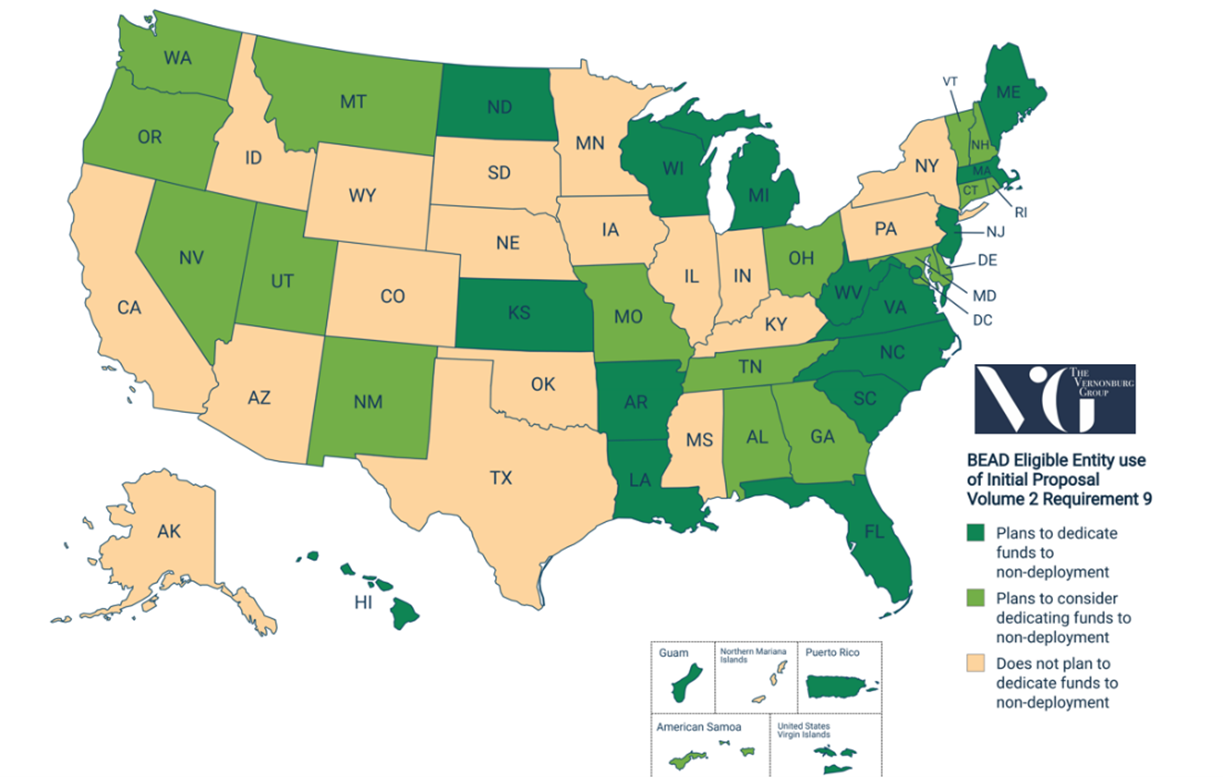NTIA Releases New BEAD FAQs: States and Territories Should Still Preserve Non-Deployment Funds
By: Greg Guice and Elena Lowinger | July 16, 2025
Guidance on the Infrastructure Act’s Broadband Equity, Access, and Deployment (BEAD) program is ever changing. Yesterday, July 15, 2025, brought the latest change. The National Telecommunications and Information Administration (NTIA) updated the BEAD Frequently Asked Questions and Answers (FAQs) to continue framing out the changes made in the Restructuring Policy Notice that was released last month.
Now, according to Version 12 of the BEAD FAQs, “Eligible Entities shall not submit information on non-deployment projects in the Final Proposal” (p. 33 and 57). By “non-deployment projects,” NTIA means activities other than the last mile connectivity projects for designated unserved and underserved locations. With all Final Proposals due to the NTIA exactly 50 days from today and over half of the BEAD Eligible Entities actively administering their deployment project Benefit of the Bargain application rounds, we’re at a critical moment for advancing digital opportunity and reaping the full benefits of the BEAD program.
Even with NTIA’s latest guideline changes, Eligible Entities need not forsake non-deployment commitments, especially considering that the statute (47 U.S.C 1702(f)) explicitly allows Eligible Entities to award BEAD subgrants for broadband adoption and other non-deployment purposes, as recently detailed by Vernonburg Group. The FAQs open by echoing this point: “[t]his document does not and is not intended to supersede, modify, or otherwise alter applicable statutory or regulatory requirements.”
Most Eligible Entities, shown in Figure 1 below, have already described distinctive plans to potentially dedicate a portion of their BEAD funds to non-deployment activities through requirement 9 of their approved Initial Proposal Volume 2 submissions.
Figure 1: BEAD Eligible Entity use of Initial Proposal Volume 2 Requirement 9
The diverse set of Eligible Entities interested in using BEAD funding for transformative non-deployment pursuits do not need to retract their commitments nor abandon their creative ideas on closing the digital divide. Further, the remaining states and territories still have plenty of time to consider how to most effectively address their unique broadband adoption challenges with their leftover BEAD funds. As Vernonburg Group’s Broadband Funding Optimization Tool demonstrated, each Eligible Entity can efficiently spend BEAD funds on an assortment of technologies to connect unserved/underserved locations—and still have significant funding – a Digital Opportunity Dividend – available for non-deployment purposes, as Congress intended.
At multiple points, the FAQs repeat that “NTIA will provide further guidance on non-deployment, including the method of submitting additional information, after concluding its review of the appropriate uses of non-deployment funding" (p. 33 and 57). Vernonburg Group will continue to update its recommendations upon the publication of additional recommendations from NTIA and ongoing activity in Congress.
Consistent with the Infrastructure Act, which passed with broad bipartisan support, and with these updates from the NTIA in mind, Vernonburg Group encourages Eligible Entities to proceed by upholding their dedication to broadband adoption. Eligible Entities should make plain their intentions to use remaining BEAD funds for non-deployment activities—perhaps in a brief footnote or within a cover letter accompanying the Final Proposals submitted to NTIA. Eligible entities need to affirmatively make clear to NTIA that they intend to use all of the funds allocated to them through the BEAD program and that they are not “unused.”
Vernonburg Group welcomes collaboration and inquiries on this matter, and we encourage State Broadband Offices and other organizations to continue developing plans that expand broadband adoption. Contact us to learn more.

